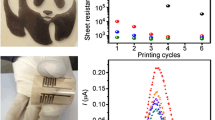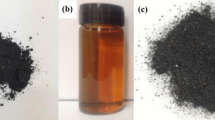Abstract
A series of inkjet printing processes have been studied using graphene-based inks. Under optimized conditions, using water-soluble single-layered graphene oxide (GO) and few-layered graphene oxide (FGO), various high image quality patterns could be printed on diverse flexible substrates, including paper, poly(ethylene terephthalate) (PET) and polyimide (PI), with a simple and low-cost inkjet printing technique. The graphene-based patterns printed on plastic substrates demonstrated a high electrical conductivity after thermal reduction, and more importantly, they retained the same conductivity over severe bending cycles. Accordingly, flexible electric circuits and a hydrogen peroxide chemical sensor were fabricated and showed excellent performances, demonstrating the applications of this simple and practical inkjet printing technique using graphene inks. The results show that graphene materials-which can be easily produced on a large scale and possess outstanding electronic properties-have great potential for the convenient fabrication of flexible and low-cost graphene-based electronic devices, by using a simple inkjet printing technique.

Similar content being viewed by others
References
Sele, C. W.; von Werne, T.; Friend, R. H.; Sirringhaus, H. Lithography-free, self-aligned inkjet printing with sub-hundred-nanometer resolution. Adv. Mater. 2005, 17, 997–1001.
De Gans, B. J.; Duineveld, P. C.; Schubert, U. S. Inkjet printing of polymers: State of the art and future developments. Adv. Mater. 2004, 16, 203–213.
Nur, H. M.; Song, J. H.; Evans, J. R. G.; Edirisinghe, M. J. Ink-jet printing of gold conductive rracks. J. Mater. Sci. -Mater. El. 2002, 13, 213–219.
Perelaer, J.; de Gans, B. J.; Schubert, U. S. Ink-jet printing and microwave sintering of conductive silver tracks. Adv. Mater. 2006, 18, 2101–2104.
Smith, P. J.; Shin, D. Y.; Stringer, J. E.; Derby, B.; Reis, N. Direct ink-jet printing and low temperature conversion of conductive silver patterns. J. Mater. Sci. 2006, 41, 4153–4158.
Magdassi, S.; Bassa, A.; Vinetsky, Y.; Kamyshny, A. Silver nanoparticles as pigments for water-based ink-jet inks. Chem. Mater. 2003, 15, 2208–2217.
Bong, K. P.; Dongjo, K.; Sunho, J.; Jooho, M.; Jang, S. K. Direct writing of copper conductive patterns by ink-jet printing. Thin Solid Films 2007, 515, 7706–7711.
Bharathan, J.; Yang, Y. Polymer electroluminescent devices processed by inkjet printing: I. Polymer light-emitting logo. Appl. Phys. Lett. 1998, 72, 2660–2662.
Beecher, P.; Servati, P.; Rozhin, A.; Colli, A.; Scardaci, V.; Pisana, S.; Hasan, T.; Flewitt, A. J.; Robertson, J.; Hsieh, G. W., et al. Ink-jet printing of carbon nanotube thin film transistors. J. Appl. Phys. 2007, 102, 043710.
Denneulin, A.; Bras, J.; Blayo, A.; Khelifi, B.; Roussel-Dherbey, F.; Neuman, C. The influence of carbon nanotubes in inkjet printing of conductive polymer suspensions. Nanotechnology 2009, 20, 385701.
Fan, Z. J.; Wei, T.; Luo, G. H.; Wei, F. Fabrication and characterization of multi-walled carbon nanotubes-based ink. J. Mater. Sci. 2005, 40, 5075–5077.
Kordas, K.; Mustonen, T.; Toth, G.; Jantunen, H.; Lajunen, M.; Soldano, C.; Talapatra, S.; Kar, S.; Vajtai, R.; Ajayan, P. M. Inkjet printing of electrically conductive patterns of carbon nanotubes. Small 2006, 2, 1021–1025.
Song, J. W.; Yoon, Y. H.; Kim, J.; Han, C. S.; Choi, B. S.; Kim, J. H. Direct fabrication and patterning of transparent conductive carbon nanotube film using inkjet printing. In SID International Symposium, Digest of Technical Papers, SID; Soc. Information Display: Long Beach, 2007; pp. 1613–1616.
Panhuis, M. I. H.; Heurtematte, A.; Small, W. R.; Paunov, V. N. Inkjet printed water sensitive transparent films from natural gum-carbon nanotube composites. Soft Matter 2007, 3, 840–843.
Wei, T.; Ruan, J.; Fan, Z. J.; Luo, G. H.; Wei, F. Preparation of a carbon nanotube film by ink-jet printing. Carbon 2007, 45, 2712–2716.
Small, W. R.; Panhuis, M. I. H. Inkjet printing of transparent, electrically conducting single-walled carbon-nanotube composites. Small 2007, 3, 1500–1503.
Geim, A. K.; Novoselov, K. S. The rise of graphene. Nat. Mater. 2007, 6, 183–191.
Bunch, J. S.; van der Zande, A. M.; Verbridge, S. S.; Frank, I. W.; Tanenbaum, D. M.; Parpia, J. M.; Craighead, H. G.; McEuen, P. L. Electromechanical resonators from graphene sheets. Science 2007, 315, 490–493.
Li, D.; Kaner, R. B. Graphene-based materials. Science 2008, 320, 1170–1171.
Yan, W.; Zhiqiang, S.; Yi, H.; Yanfeng, M.; Chengyang, W.; Mingming, C.; Yongsheng, C. Supercapacitor devices based on graphene materials. J. Phys. Chem. C 2009, 113, 13103–13107.
Stoller, M. D.; Park, S. J.; Zhu, Y. W.; An, J. H.; Ruoff, R. S. Graphene-based ultracapacitors. Nano Lett. 2008, 8, 3498–3502.
Chen, Y. S.; Xu, Y. F.; Zhao, K.; Wan, X. J.; Deng, J. Ch. Towards flexible all-carbon electronics: Flexible organic field-effect transistors and inverter circuits using solution-processed all graphene source/drain/gate electrodes. Nano Res. 2010, 10, 714–721.
He, Q.; Sudibya, H. G.; Yin, Z.; Wu, S.; Li, H.; Boey, F.; Huang, W.; Chen, P.; Zhang, H. Centimeter-long and large-scale micropatterns of reduced graphene oxide films: Fabrication and sensing applications. ACS Nano 2010, 4, 3201–3208.
Wang, X.; Zhi, L. J.; Mullen, K. Transparent, conductive graphene electrodes for dye-sensitized solar cells. Nano Lett. 2008, 8, 323–327.
Junbo, W.; Becerril, H.; Zhenan, B.; Zunfeng, L.; Yongsheng, C.; Peumans, P. Organic solar cells with solution-processed graphene transparent electrodes. Appl. Phys. Lett. 2008, 92, 263302.
Xu, Y. F.; Long, G. K.; Huang, L.; Huang, Y.; Wan, X. J.; Ma, Y. F.; Chen, Y. S. Polymer photovoltaic devices with transparent graphene electrodes produced by spin-casting. Carbon 2010, 48, 3308–3311.
Liu, Q.; Liu, Z. F.; Zhong, X. Y.; Yang, L. Y.; Zhang, N.; Pan, G. L.; Yin, S. G.; Chen, Y.; Wei, J. Polymer photovoltaic cells based on solution-processable graphene and P3HT. Adv. Funct. Mater. 2009, 19, 894–904.
Yin, Z.; Sun, S.; Salim, T.; Wu, S.; Huang, X.; He, Q.; Lam, Y. M.; Zhang, H. Organic photovoltaic devices using highly flexible reduced graphene oxide films as transparent electrodes. ACS Nano 2010, 4, 5263–5268.
Fowler, J. D.; Allen, M. J.; Tung, V. C.; Yang, Y.; Kaner, R. B.; Weiller, B. H. Practical chemical sensors from chemically derived graphene. ACS Nano 2009, 3, 301–306.
Robinson, J. T.; Perkins, F. K.; Snow, E. S.; Wei, Z. Q.; Sheehan, P. E. Reduced graphene oxide molecular sensors. Nano Lett. 2008, 8, 3137–3140.
Wang, Z.; Zhou, X.; Zhang, J.; Boey, F.; Zhang, H. Direct electrochemical reduction of single-layer graphene oxide and subsequent functionalization with glucose oxidase. J. Phys. Chem. C 2009, 113, 14071–14075.
Zhou, X.; Wei, Y.; He, Q.; Boey, F.; Zhang, Q.; Zhang, H. Reduced graphene oxide films used as matrix of MALDI-TOF-MS for detection of octachlorodibenzo-p-dioxin. Chem. Commun. 2010, 46, 6974–6976.
Wu, J. B.; Agrawal, M.; Becerril, H. A.; Bao, Z. N.; Liu, Z. F.; Chen, Y. S.; Peumans, P. Organic light-emitting diodes on solution-processed graphene transparent electrodes. ACS Nano 2010, 4, 43–48.
Wang, S.; Ang, P. K.; Wang, Z. Q.; Tang, A. L. L.; Thong, J. T. L.; Loh, K. P. High mobility, printable, and solution-processed graphene electronics. Nano Lett. 2010, 10, 92–98.
Dua, V.; Surwade, S. P.; Ammu, S.; Agnihotra, S. R.; Jain, S.; Roberts, K. E.; Park, S.; Ruoff, R. S.; Manohar, S. K. All-organic vapor sensor using inkjet-printed reduced graphene oxide. Angew. Chem. Int. Ed. 2010, 49, 2154–2157.
Becerril, H. A.; Mao, J.; Liu, Z.; Stoltenberg, R. M.; Bao, Z.; Chen, Y. Evaluation of solution-processed reduced graphene oxide films as transparent conductors. ACS Nano. 2008, 2, 463–470.
Hummers, W. S.; Offeman, R. E. Preparation of graphitic oxide. J. Am. Chem. Soc. 1958, 80, 1339.
Liu, Z. F.; Liu, Q.; Huang, Y.; Ma, Y. F.; Yin, S. G.; Zhang, X. Y.; Sun, W.; Chen, Y. S. Organic photovoltaic devices based on a novel acceptor material: Graphene. Adv. Mater. 2008, 20, 3924–3930.
Zhang, L.; Li, X.; Huang, Y.; Ma, Y. F.; Wan, X. J.; Chen, Y. S. Controlled synthesis of few-layered graphene sheets on a large scale using chemical exfoliation. Carbon 2010, 48, 2367–2371.
Long, Z.; Jiajie, L.; Yi, H.; Yanfeng, M.; Yan, W.; Yongsheng, C. Size-controlled synthesis of graphene oxide sheets on a large scale using chemical exfoliation. Carbon 2009, 47, 3365–3368.
Zhou, X.; Huang, X.; Qi, X.; Wu, S.; Xue, C.; Boey, F. Y. C.; Yan, Y.; Chen, P.; Zhang, H. In situ synthesis of metal nanoparticles on single-layer graphene oxide and reduced graphene oxide surfaces. J. Phys. Chem. C 2009, 113, 10842–10846.
Stankovich, S.; Dikin, D. A.; Piner, R. D.; Kohlhaas, K. A.; Kleinhammes, A.; Jia, Y.; Wu, Y.; Nguyen, S. T.; Ruoff, R. S. Synthesis of graphene-based nanosheets via chemical reduction of exfoliated graphite oxide. Carbon 2007, 45, 1558–1565.
Yang, X. Y.; Lu, Y. H.; Ma, Y. F.; Li, Y. J.; Du, F.; Chen, Y. S. Noncovalent nanohybrid of ferrocene with single-walled carbon nanotubes and its enhanced electrochemical property. Chem. Phys. Lett. 2006, 420, 416–420.
Magdassi, S.; Ben Moshe, M. Patterning of organic nano-particles by ink-jet printing of microemulsions. Langmuir 2003, 19, 939–942.
Kim, Y. -K.; Min, D. -H. Durable large-area thin films of graphene/carbon nanotube double layers as a transparent electrode. Langmuir 2009, 25, 11302–11306.
Guo, T. F.; Chang, S. C.; Pyo, S.; Yang, Y. Vertically integrated electronic circuits via a combination of self-assembled polyelectrolytes, ink-jet printing, and electroless metal plating processes. Langmuir 2002, 18, 8142–8147.
Yoo, D.; Shiratori, S. S.; Rubner, M. F. Controlling bilayer composition and surface wettability of sequentially adsorbed multilayers of weak polyelectrolytes. Macromolecules 1998, 31, 4309–4318.
Deegan, R.; Bakajin, O.; Dupont, T.; Huber, G.; Nagel, S.; Witten, T. Capillary flow as the cause of ring stains from dried liquid drops. Nature 1997, 389, 827–829.
Author information
Authors and Affiliations
Corresponding authors
Electronic supplementary material
Rights and permissions
About this article
Cite this article
Huang, L., Huang, Y., Liang, J. et al. Graphene-based conducting inks for direct inkjet printing of flexible conductive patterns and their applications in electric circuits and chemical sensors. Nano Res. 4, 675–684 (2011). https://doi.org/10.1007/s12274-011-0123-z
Received:
Revised:
Accepted:
Published:
Issue Date:
DOI: https://doi.org/10.1007/s12274-011-0123-z




